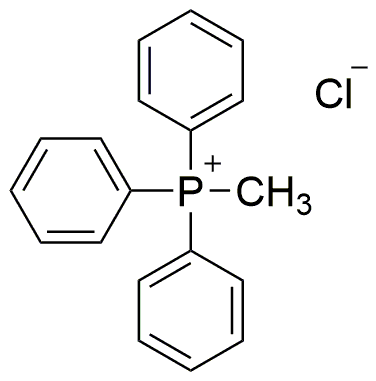Methyltriphenylphosphonium chloride is widely utilized in research focused on:
- Synthesis of Organophosphorus Compounds: This compound serves as a key reagent in the synthesis of various organophosphorus compounds, which are important in agriculture and pharmaceuticals.
- Phase Transfer Catalysis: It acts as a phase transfer catalyst in organic reactions, enhancing the efficiency of reactions that involve immiscible phases, thus saving time and resources in chemical processes.
- Biological Research: Its ability to penetrate cell membranes makes it valuable in biological studies, particularly in investigating cellular processes and drug delivery systems.
- Organic Synthesis: Methyltriphenylphosphonium chloride is used in the Wittig reaction, a fundamental method for forming carbon-carbon double bonds, which is essential in the synthesis of complex organic molecules.
- Material Science: It finds applications in the development of advanced materials, including polymers and catalysts, due to its unique chemical properties and reactivity.
General Information
Properties
Safety and Regulations
Applications
Methyltriphenylphosphonium chloride is widely utilized in research focused on:
- Synthesis of Organophosphorus Compounds: This compound serves as a key reagent in the synthesis of various organophosphorus compounds, which are important in agriculture and pharmaceuticals.
- Phase Transfer Catalysis: It acts as a phase transfer catalyst in organic reactions, enhancing the efficiency of reactions that involve immiscible phases, thus saving time and resources in chemical processes.
- Biological Research: Its ability to penetrate cell membranes makes it valuable in biological studies, particularly in investigating cellular processes and drug delivery systems.
- Organic Synthesis: Methyltriphenylphosphonium chloride is used in the Wittig reaction, a fundamental method for forming carbon-carbon double bonds, which is essential in the synthesis of complex organic molecules.
- Material Science: It finds applications in the development of advanced materials, including polymers and catalysts, due to its unique chemical properties and reactivity.
Documents
Safety Data Sheets (SDS)
The SDS provides comprehensive safety information on handling, storage, and disposal of the product.
Product Specification (PS)
The PS provides a comprehensive breakdown of the product’s properties, including chemical composition, physical state, purity, and storage requirements. It also details acceptable quality ranges and the product's intended applications.
Certificates of Analysis (COA)
Search for Certificates of Analysis (COA) by entering the products Lot Number. Lot and Batch Numbers can be found on a product’s label following the words ‘Lot’ or ‘Batch’.
*Catalog Number
*Lot Number
Certificates Of Origin (COO)
This COO confirms the country where the product was manufactured, and also details the materials and components used in it and whether it is derived from natural, synthetic, or other specific sources. This certificate may be required for customs, trade, and regulatory compliance.
*Catalog Number
*Lot Number
Safety Data Sheets (SDS)
The SDS provides comprehensive safety information on handling, storage, and disposal of the product.
DownloadProduct Specification (PS)
The PS provides a comprehensive breakdown of the product’s properties, including chemical composition, physical state, purity, and storage requirements. It also details acceptable quality ranges and the product's intended applications.
DownloadCertificates of Analysis (COA)
Search for Certificates of Analysis (COA) by entering the products Lot Number. Lot and Batch Numbers can be found on a product’s label following the words ‘Lot’ or ‘Batch’.
*Catalog Number
*Lot Number
Certificates Of Origin (COO)
This COO confirms the country where the product was manufactured, and also details the materials and components used in it and whether it is derived from natural, synthetic, or other specific sources. This certificate may be required for customs, trade, and regulatory compliance.


